Home » Learn » Articles on Acoustics » Archaeoacoustics
Archaeoacoustics (archaeological acoustics) is an interdisciplinary research field that focuses on acoustical aspects of archaeological sites and artifacts.
Recent developments in digital modelling, virtual reality, and augmented reality have contributed significantly to increasing research activity in archaeoacoustics. Especially in relation to buildings, the acoustical virtual reality is a powerful tool that makes it possible to reconstruct the sound in rooms or buildings that have disappeared or have been changed significantly over the years.
The following overview of the research field is divided into the following areas: Archaeological sites, lithophony, ancient theatres, worship spaces and liturgical archaeology.
Acoustical phenomena of ancient archaeological sites
Some archaeological sites present acoustical peculiarities that may still be audible by today’s visitors. Some archaeoacoustic studies have investigated Neolithic structures and identified acoustical resonances that may or may not have contributed to their functional purposes (Devereux et al. 1996).
Some stone chambers were found to have acoustical resonances around 110 Hz, and this coincides with the fundamental of the male voice. However, it is impossible to draw any conclusions from such observations. Other studies have looked into the acoustics of the famous Neolithic stone circle, Stonehenge in England (Cox et al. 2020). As this structure is not completely preserved, the applied methodology is either acoustical measurements in scale models of the reconstructed site, or computer simulations in digital models of the reconstructed site.
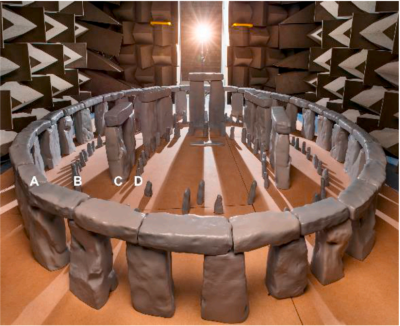
Scale model of the reconstructed Stonehenge in a semi-anechoic chamber (Cox et al 2020, Fig. 1)
Another example of interesting archaeoacoustics is the Kukulkan pyramid in Chichen Itza, Mexico, dating from the ancient Maya culture. Due to the geometry of the stone steps of the pyramid, the sound reflections from a hand clap near the pyramid creates a very special sound that mimics the chirping call of a local bird. Some researches that have studied this phenomenon believe that this is not accidental, but the builders should have designed the pyramid precisely to create this acoustical effect. However, other researches have argued against this hypothesis (Declercq et al. 2004).
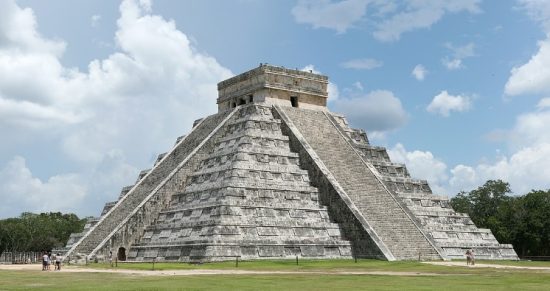
The Kukulkan pyramid in Chichen Itza (en.wikipedia.org).
Lithophony
Some rocks have special acoustical properties, and when shaped like columns, either by nature or by man, they can be very resonant. When hit by a light blow, the rock can emit a sound with a clear musical pitch. Such musical columns can be found in caves or in building structures. When found in caves, one can speculate to what extend this phenomenon has been known and used by people in ancient times.
However, in a building structure like the Vitthala temple in Hampi, India, there is no doubt that the musical columns were carved from the rock on purpose. The temple was built in the 15th century, and it contains 56 monolithic pillars, each with a unique group of musical columns. Acoustical studies of this temple have been reported by Kumar et al. (2008).
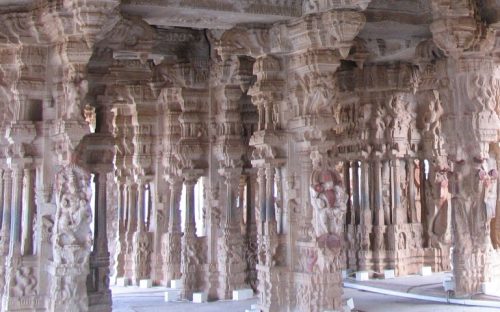
Some of the pillars with musical columns in the Vitthala temple (Photo: J.H. Rindel).
The video below shows the Vitthala temple columns producing specific musical notes:
Ancient theatres
The ancient Greek and Roman theatres are among the most precious and spectacular items of cultural heritage in the Mediterranean countries. In the ERATO project on archaeoacoustics, the 3D virtual reality technology was applied to create integrated visual and acoustical restorations of some selected theatres. The project included the originally Greek theatre in Syracusa, the Roman theatre in Aspendos and Jerash, and the Odeon (roofed theatre) in Aphrodisias and Aosta.
Below is a photo showing the remains of the odeon in Aphrodisias and a view into the acoustical model of the restored room. In addition to the virtual restoration of the architecture, some ancient musical instruments were reconstructed, and short music pieces were composed and recorded to be applied for auralisation.
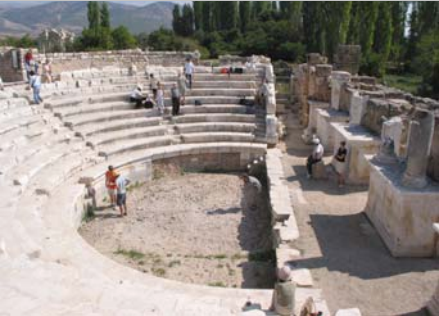
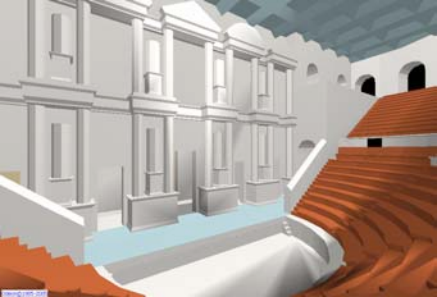
The Odeon in Aphrodisias as it looks today and the restored digital model for acoustical simulations.

Musical instruments reproduced for the ERATO project (from left): Kithara, tympanon, scabellum, and aulos.
The video below shows a visual and acoustic recreation of the odeon in Aphrodisias:
Ancient worship spaces
In recent years, several research projects in archaeoacoustics have been devoted to the study of ancient worship spaces. The methodology is usually the same as for the ancient theatres;
Registration of the current properties of the room including acoustical measurements,
Creation of a virtual room model that can be changed in order to restore the room to the original state or another previous state, and finally
Auralisation by using anechoic recordings of sounds that could be relevant for the case.
One of the first major projects in this field was the CAHRISMA project. In this project the 3D virtual reality technology was applied to create integrated visual and acoustical restorations of some selected Byzantine churches and Sinan mosques. The largest and most famous building studied in this project is the Hagia Sophia, built in 537 as a church in the Byzantine Empire. In 1453 it was converted into a mosque in the Ottoman Empire, and in 1934 it became a museum.
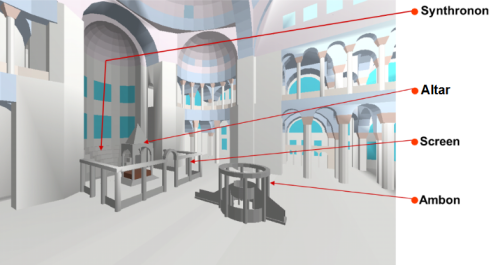
Acoustical model of Hagia Sophia restored as Byzantine church. Several items have been removed and other items have been inserted (altar, screen, and ambon). The synthronon is a semicircular tiered structure at the back of the altar. The ambon is an elevated platform used in the Byzantine liturgy.
A researcher in Byzantine liturgy (Christian Troelsgård from the University of Copenhagen) has recreated the Byzantine Alleluia, traditionally sung in Hagia Sophia first Sunday after Easter according to the Typicon of the Great Church, dating back to around 950. This is the oldest document with precise information on the cathedral liturgy in Hagia Sophia. The music is transcribed from manuscripts in the Vatican Library. The anechoic recording and auralisation of the hymn have been made in cooperation with the researchers at Odeon A/S.
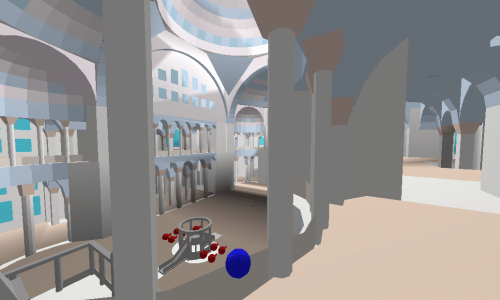
View from receiver
Another example of within the field archaeoacoustics of worship spaces, is a project with the goal of virtual recovery of the sound of the Hispanic Rite celebrated by Christians of the Iberian Peninsula before the imposition of the Roman Rite in the mid-eleventh century. Acoustical models of Pre-Romanesque churches in their original state are used for auralisation, and the rites are reconstructed following the hypothesis proposed by leading researchers in medieval liturgical archaeology (Pedrero et al. 2014).
References
R.G. Jahn, P. Devereux, M. Ibison (1996). Acoustical resonances of assorted ancient structures. J. Acoust. Soc. Am. 99, 649-658.
T.J. Cox, B.M. Fazenda, S.E. Greaney (2020). Ysing scale modelling to assess the prehistoric acoustics of Stonehenge. Journal of Archaeological Science 122, 105218.
N.F. Declercq, J. Degrieck, R. Briers, O. Leroy (2004). A theoretical study of special acoustic effects caused by the staircase of the El Castillo pyramid at the Maya ruins of Chichen-Itza in Mexico. J. Acoust. Soc. Am. 116, 3328-3335.
A. Kumar, T. Jayakumar, C. Babu Rao, Godvind K. Sharma, K.V. Rajkumar, B. Raj (2008). Nondestructive characterization of musical pillars of Mahamandapam of Vitthala Temple at Hampi, India. J. Acoust. Soc. Am. 124, 911-917.
ERATO, Final Report. INCO-MED project ICA3-CT2002-10031, 2006.
CAHRISMA, Final Report. INCO-MED project ICA3- 1999-00007, 2003.
A. Pedrero, A. Diaz-Chyla, C. Diaz, S. Pelzer, M. Vorländer (2014). Virtual restoration of the sound of the Hispanic Rite. Proceedings of Forum Acusticum, 7-12 September 2014, Krakow, Poland.


